
Volume 31, No. 4 – April 2018
Website:
www.CivilWarRoundTablePalmBeach.org
President’s Message:
If you were not
present at the March meeting, you miss a phenomenal presentation by
historian and author, Jack Davis.
Not only did we learn about how the 524 letters written by
General Wharton and the love of his life were found, but we were also
privy to their contents. In
addition, there was surprising information about the War and the history
of Virginia. Thank to Bob
Franke for asking Jack Davis to speak and hosting him during his visit.
Our condolences to the family of Alan Konzelman who
passed away on February 18th.
Alan was a long standing member and very generous to the Round
Table. He graciously donated
our current coffeemaker.
Gerridine LaRovere
April 11, 2018 Program:
This month there will be a two part
program. Janell Bloodworth speak about
The Strange Life of Abraham
Lincoln’s Sister-in-Law, Emilie Todd Helm.
The second part will be given by Gerridine LaRovere and she will
talk about
The Peculiar Life of Mary Lee,
Robert E. Lee’s Eldest Daughter.
Both of these women had very interesting lives.
March 14, 2018 Program:
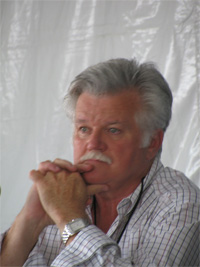 Our
March speaker was Jack Davis.
Mr. Davis was a professor of history at Virginia Tech and
director of programs for Civil War Studies.
He has been twice nominated for the Pulitzer Prize for
“Breckenridge: Statesman, Soldier, Symbol” and “Battle at Bull Run.”
As an expert on Confederate and Southern History, he consults for
numerous television productions and the History Channel.
His presentation was titled:
The
General in Love, The story of General Gabriel C. Wharton's CSA courtship
and marriage. Our
March speaker was Jack Davis.
Mr. Davis was a professor of history at Virginia Tech and
director of programs for Civil War Studies.
He has been twice nominated for the Pulitzer Prize for
“Breckenridge: Statesman, Soldier, Symbol” and “Battle at Bull Run.”
As an expert on Confederate and Southern History, he consults for
numerous television productions and the History Channel.
His presentation was titled:
The
General in Love, The story of General Gabriel C. Wharton's CSA courtship
and marriage.
Mr. Davis began his
presentation with the discovery of 15 boxes and 2 trunks in the late
1980s. Inside of this trove
was 524 letters between Gabriel Wharton and his wife Anne "Nannie"
Radford. It was a remarkable
find for a number of reasons.
First, that this collection survived from the mid-19th century until the
late 20th.
Second, that they further survived for 20 additional years in a
hot Florida garage. And
finally, there were letters from her to him.
This is most unusual as the things that soldiers carried were
usually lost under the stress of combat.
Wharton was born in
Culpeper County, Virginia, in the summer of 1824.
AP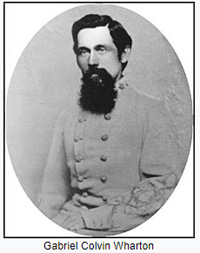 Hill was a school yard friend.
He entered Virginia Military Institute in Lexington on September
1, 1845. Wharton graduated on July 5, 1847, finishing 2nd out of 12
cadets as a "distinguished graduate." After leaving VMI he then
became a civil engineer. Later Wharton moved to the Arizona Territory
and took up work as a mining engineer.
Hill was a school yard friend.
He entered Virginia Military Institute in Lexington on September
1, 1845. Wharton graduated on July 5, 1847, finishing 2nd out of 12
cadets as a "distinguished graduate." After leaving VMI he then
became a civil engineer. Later Wharton moved to the Arizona Territory
and took up work as a mining engineer.
At the start of the
war in 1861, Wharton chose to follow his home state of Virginia and the
Confederate cause, and entered the Confederate Army.
He was appointed a major in the 45th Virginia Infantry on July 1th, and soon afterward
was given command of the 51st Virginia Infantry on July 17, with the
rank of colonel. The 51st
Virginia was part of Maj. Gen. John B. Floyd's operations in western
Virginia, and escaped with Floyd on February 14, 1862, during the Battle
of Fort Donelson. Wharton
was then sent to the Western Theater, and commanded several brigades in
various Confederate departments from February to September 1864.
In March 1863
39-year-old Gabriel Wharton, CSA, became engaged to 19-year-old
"Nannie," daughter of Dr.
John Blair Radford, founder of Radford, Virginia. From the time of
their engagement until the end of the war they wrote to each other
almost every day, and sometimes twice a day in the early months.
They wrote about everything—ambition for promotion, opinions of generals
and political leaders, observations on campaigns and battles, the war in
Southwest Virginia where she lived, his observations on service under R.
E. Lee in northern
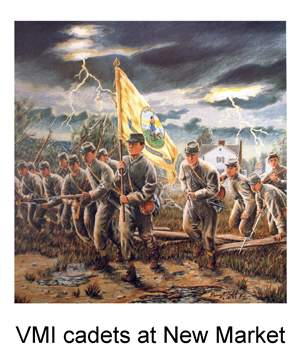 Virginia,
under James Longstreet in East Tennessee, and especially the war in the
Shenandoah Valley in 1863-64, where he commanded a brigade in the famed
Battle of New Market and later in battle at Winchester, Fisher's Hill,
and Cedar Creek. Floyd promoted Wharton to brigadier general,
effective July 8, 1863. Virginia,
under James Longstreet in East Tennessee, and especially the war in the
Shenandoah Valley in 1863-64, where he commanded a brigade in the famed
Battle of New Market and later in battle at Winchester, Fisher's Hill,
and Cedar Creek. Floyd promoted Wharton to brigadier general,
effective July 8, 1863.
One of the most remarkable features of the letters is the
high degree of education of both parties. Their letters are
peppered with references and quotations to current and past literature,
and both stayed as well informed as the Confederate press allowed.
It is interesting to note the almost "modern" nature of the writers.
Gabriel was very much in touch with his "feelings," and did not hesitate
to write about them to his wife, and at length. Nannie was bold,
opinionated, up-to-date on public affairs, and very much a 21st century
woman. Mr. Davis pointed out the way in which the reader can watch
the growing intimacy between them as they essentially got to know each
other via their letters during the months the war kept them apart.
Indeed, their romance was more important to them than the war, and they
often spoke of leaving the country if it got too much in the way.
The letters represent a wonderful window on the war in Southwest
Virginia that their letters open. We know of no other source that
provides as much illumination on that vital, yet much overlooked,
territory that was the sole link between the eastern and western
Confederacy. The important family and friendship connections of
both gave them ears on significant issues and operations. Nannie's
letters especially illuminate the Confederate home and community life of
a well-to-do young woman in a more rural community than most of the
Confederate matrons' diaries and memoirs.
To illustrate these
points Mr. Davis mentioned the details of their honeymoon hotel and
points about obscure poets.
The couple were slave holders and had no issues with that concept, but
were often at odds with the Confederate States of America.
Both seemed to hate Jefferson Davis.
On other leaders there was a difference of opinion.
For example Nannie disliked James Longstreet while Gab respected
him. The same was their
opinion of Robert E. Lee. It
was pointed out that Gabriel was ever the optimist.
He was sad after Gettysburg, but still had high hopes for the
cause right up till 1865.
They concluded that
slavery was dead as the war was approaching its end.
Their personal plan was to escape to Europe, but this was not
carried out. While 10,000
confederates left the country, the Wharton family stayed on.
Nannie was terrified of childbirth even after the successful
delivery of their son. Gab
asked for parole and was granted same.
He went on to executive work on railroads and mines.
She ran a hotel, was an editor, and real estate developer.
She died in 1890 and he in 1906.
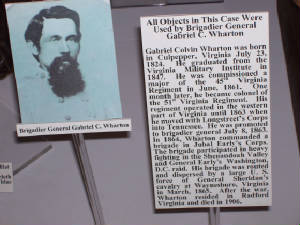 The story of the
letters themselves is remarkable. Their survival is almost
miraculous. Before his death General Wharton placed on top of the
boxes of letters instructions that they should be burned at his death.
Thankfully no one paid attention. Indeed, no one even knew
they existed. In 1973, when the Wharton’s grandson was contacted
to ask if any of the general's papers survived, he responded that there
were none. Two floors above
him in the attic of the general's house "Glencoe," where he lived, sat
15 boxes and two trunks of the Wharton papers. They were only
discovered in 1988 when the house was sold and become a museum in the
city of Radford, and the attic was cleaned out. For the next 20+
years the letters sat in a garage in Florida until the Wharton’s
great-great-granddaughter Sue Heth Bell, of Wellesley, MA, took them to
her home for safekeeping. The story of the
letters themselves is remarkable. Their survival is almost
miraculous. Before his death General Wharton placed on top of the
boxes of letters instructions that they should be burned at his death.
Thankfully no one paid attention. Indeed, no one even knew
they existed. In 1973, when the Wharton’s grandson was contacted
to ask if any of the general's papers survived, he responded that there
were none. Two floors above
him in the attic of the general's house "Glencoe," where he lived, sat
15 boxes and two trunks of the Wharton papers. They were only
discovered in 1988 when the house was sold and become a museum in the
city of Radford, and the attic was cleaned out. For the next 20+
years the letters sat in a garage in Florida until the Wharton’s
great-great-granddaughter Sue Heth Bell, of Wellesley, MA, took them to
her home for safekeeping.
Sue Heth Bell and
William C. Davis are co-editors on the project. She has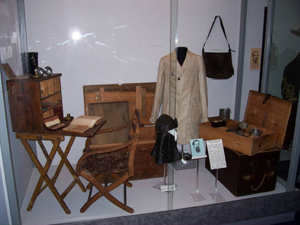 prepared the transcriptions of all of the letters, and he has annotated
them all, providing introductions for chapters, etc., and will write an
introductory essay bringing them up to the war, and a concluding essay
dealing with their remarkable post-war lives as rebuilders of their
region's economy. The letters have all gone through a final edit,
and at the moment are full transcripts. We hope that they can be
published in their entirety, though at 395,000 words (including
annotations) before introduction and conclusion, it will make a very
large book to be sure, probably on the order of 800+ book pages.
prepared the transcriptions of all of the letters, and he has annotated
them all, providing introductions for chapters, etc., and will write an
introductory essay bringing them up to the war, and a concluding essay
dealing with their remarkable post-war lives as rebuilders of their
region's economy. The letters have all gone through a final edit,
and at the moment are full transcripts. We hope that they can be
published in their entirety, though at 395,000 words (including
annotations) before introduction and conclusion, it will make a very
large book to be sure, probably on the order of 800+ book pages.
The Wharton home
"Glencoe" is very interested in this project and has already hosted a
couple of events where the co-editors have spoken. They have also
done an exhibit featuring the letters, and established a board solely
charged with promoting the story of the correspondence in tandem with
the museum. The city of Radford, and the president of Radford
University are also much interested and have hosted, or will host,
events telling the Wharton story. The Roanoke
Times on October 7, 2017
ran a three-page feature leading the front page of its Sunday main
section, which provides more detail and color.
Last changed: 03/29/18
Home
About News
Newsletters
Calendar
Memories
Links Join
|

